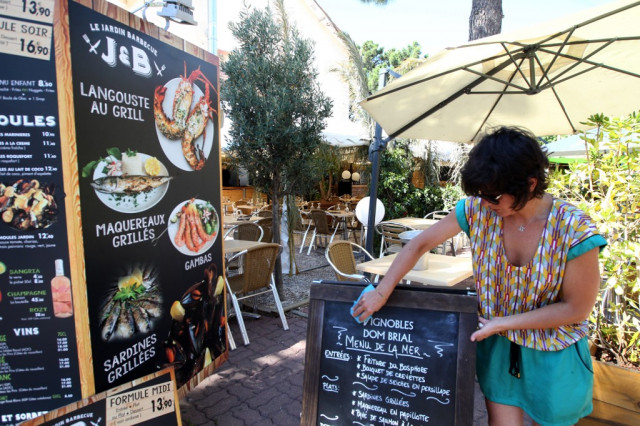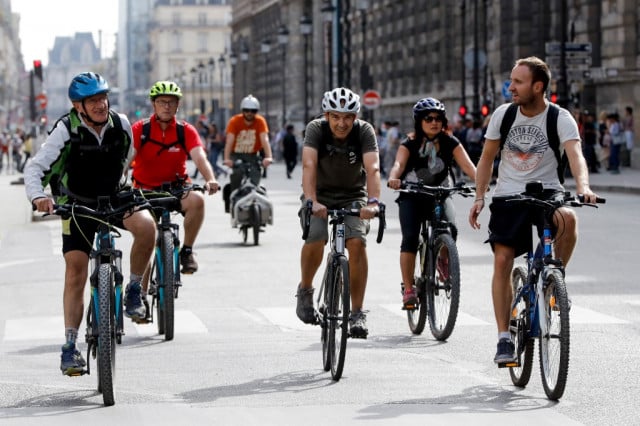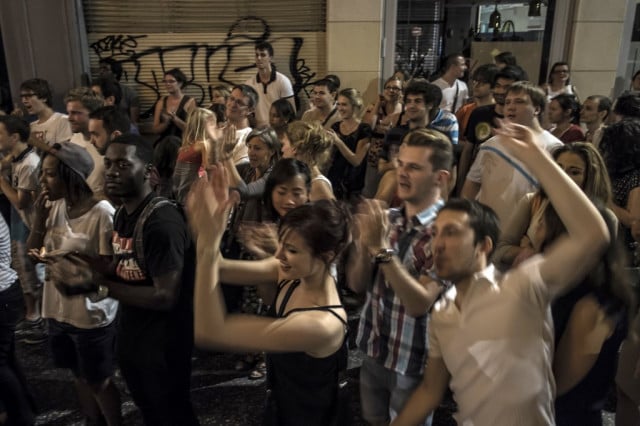Five things that America can learn from France

After two years in France, American student and sometimes Local France writer Edward O'Reilly is heading home. We asked him what his native country can learn from France.
As my second year in France winds to a close and I prepare to head back to the States, I have to admit that I’m looking forward to being home. But I know that once I arrive, whether it be in a few weeks or a few months, there will be things that I’ll miss about France.
And not just bread, cheese, and wine - although obviously, I will be missing that - but also the way that French create and maintain the livability that attracts so many foreigners to France.
READ ALSO
-
France vs USA: Eleven things the French have given America
-
Top 10 French jokes about the Brits and the Yanks
 The French TGV trains make travel across the country easy. Photo: AFP
Here are a few ideas that America could pick up from the French:
Cheap travel
When Americans talk about how easy it is to hop from one country or historic city to another in Europe, they tend to attribute this facility only to geographic proximity - which is undeniable. The distance that one must travel for a wholesale change of scenery is much less here than in the States.
But there is also another reason it’s much easier to travel around France, or Europe in general: there are far more low price options for travelers. Someone who wants to go from Paris to Lyon without driving themselves will have plenty of options that are more or less affordable and make travelling easy.
The European Union airline market, open to international competitors, allows numerous low-cost airlines from different countries to compete for clients, leading to flights that can be found for less than the cost of a meal at a restaurant.
France’s investment in a high speed rail network means that the train can get you from Paris to Lyon in less than two hours, or Marseille in just over three.
At least three competing coach bus carriers offer bargain-basement prices, with tickets from Paris to Lyon for as little as €5. And if you’re booking last minute and tickets have sold out, you can usually hitch a ride with someone who is driving there anyway, thanks to the French ride-sharing app BlablaCar.
This platform allows you to choose from drivers offering a place in their vehicle based on departure time, pick-up and drop-off locations, and user feedback, in return for sharing the cost of gas and tolls, and maybe a little bit of friendly conversation.
A quick trip to the website ComparaBus will show all four modes of transportation and the price of each. When it comes to ease of movement, there's no comparison between France and the US.
The French TGV trains make travel across the country easy. Photo: AFP
Here are a few ideas that America could pick up from the French:
Cheap travel
When Americans talk about how easy it is to hop from one country or historic city to another in Europe, they tend to attribute this facility only to geographic proximity - which is undeniable. The distance that one must travel for a wholesale change of scenery is much less here than in the States.
But there is also another reason it’s much easier to travel around France, or Europe in general: there are far more low price options for travelers. Someone who wants to go from Paris to Lyon without driving themselves will have plenty of options that are more or less affordable and make travelling easy.
The European Union airline market, open to international competitors, allows numerous low-cost airlines from different countries to compete for clients, leading to flights that can be found for less than the cost of a meal at a restaurant.
France’s investment in a high speed rail network means that the train can get you from Paris to Lyon in less than two hours, or Marseille in just over three.
At least three competing coach bus carriers offer bargain-basement prices, with tickets from Paris to Lyon for as little as €5. And if you’re booking last minute and tickets have sold out, you can usually hitch a ride with someone who is driving there anyway, thanks to the French ride-sharing app BlablaCar.
This platform allows you to choose from drivers offering a place in their vehicle based on departure time, pick-up and drop-off locations, and user feedback, in return for sharing the cost of gas and tolls, and maybe a little bit of friendly conversation.
A quick trip to the website ComparaBus will show all four modes of transportation and the price of each. When it comes to ease of movement, there's no comparison between France and the US.
 French students will fight to keep their affordable higher education. Photo: AFP
Affordable higher education
In my first year in France, as a student at Université de Rennes II, I made a shocking realization: public university education is almost free: €170 ($194) per year as an undergraduate, €243 ($277) per year for a Masters, and €380 ($433) per year as a doctoral student.
Many of the international students I met there had been attracted to universities in France because of their affordability.
The announcement in 2018 by Prime Minister Édouard Philippe that university tuition would be raised to €2,770 ($3,153) annually for undergrads and €3,770 ($4,291) for graduate students from outside the European Union was met with outrage and protest from university students across France, and not just the ones from outside the EU - France’s major student unions were among the protestors.
Even more prestigious private schools like Paris’s Sciences Po, alma mater of President Emmanuel Macron, have tuitions that seem fairly modest (€14,500/$16,496/year) when compared to their more expensive American counterparts like Columbia University in New York, where graduate tuition and fees amount to more than $68,000 (more than €60,000) per year.
Meanwhile, Americans spend an average of $30,000 (€26,367) per student per year, according to the OECD. As a result, Americans are now struggling under 1.47 trillion dollars in student loan debt. Sure, elite US Universities are the most highly ranked in the world, but what does that do for the more than 99 percent of American college students who won’t be attending them?
French students will fight to keep their affordable higher education. Photo: AFP
Affordable higher education
In my first year in France, as a student at Université de Rennes II, I made a shocking realization: public university education is almost free: €170 ($194) per year as an undergraduate, €243 ($277) per year for a Masters, and €380 ($433) per year as a doctoral student.
Many of the international students I met there had been attracted to universities in France because of their affordability.
The announcement in 2018 by Prime Minister Édouard Philippe that university tuition would be raised to €2,770 ($3,153) annually for undergrads and €3,770 ($4,291) for graduate students from outside the European Union was met with outrage and protest from university students across France, and not just the ones from outside the EU - France’s major student unions were among the protestors.
Even more prestigious private schools like Paris’s Sciences Po, alma mater of President Emmanuel Macron, have tuitions that seem fairly modest (€14,500/$16,496/year) when compared to their more expensive American counterparts like Columbia University in New York, where graduate tuition and fees amount to more than $68,000 (more than €60,000) per year.
Meanwhile, Americans spend an average of $30,000 (€26,367) per student per year, according to the OECD. As a result, Americans are now struggling under 1.47 trillion dollars in student loan debt. Sure, elite US Universities are the most highly ranked in the world, but what does that do for the more than 99 percent of American college students who won’t be attending them?
 French cuisine may not be healthy, but the portion sizes certainly are. Photo AFP
A healthier relationship with food
Embedded deep within the American psyche is the idea that, when it comes to food, more is better. The more time that I’ve spent out of the United States, the more apparent it becomes that the portion size of meals in the US is totally out of control.
A little bit of research reveals that this is not just a personal feeling, but a fact, confirmed by organizations like the National Heart, Lung, and Blood Institute, which says that food portions in American restaurants have more than doubled in the last 25 years.
Meanwhile, French cuisine continues to make ample use of fatty ingredients - Julia Child summed up this attitude when she famously said, “If you’re afraid of butter, use cream” - while the French remain, on average, far trimmer than Americans.
The most recent World Health Organization figures qualify more than a third of American adults as obese, compared to about one-fifth of French adults.
How do the French do it? For one thing, the government actually takes measures to control the over-consumption that the big food industry tends to promote.
In 2017, it became illegal for French restaurants to offer unlimited refills on soft drinks, as part of an effort to combat obesity.
And all food advertising will soon be required to carry a “Nutri-score” label, which classes prepared food products from A to E and green to red based on their nutritional quality. Of course, there are also probably a number of social and cultural factors involved in our differing consumption habits, but there is no reason why the American government cannot take measures to protect their citizens from the food industry’s efforts to constantly push them to consume more.
French cuisine may not be healthy, but the portion sizes certainly are. Photo AFP
A healthier relationship with food
Embedded deep within the American psyche is the idea that, when it comes to food, more is better. The more time that I’ve spent out of the United States, the more apparent it becomes that the portion size of meals in the US is totally out of control.
A little bit of research reveals that this is not just a personal feeling, but a fact, confirmed by organizations like the National Heart, Lung, and Blood Institute, which says that food portions in American restaurants have more than doubled in the last 25 years.
Meanwhile, French cuisine continues to make ample use of fatty ingredients - Julia Child summed up this attitude when she famously said, “If you’re afraid of butter, use cream” - while the French remain, on average, far trimmer than Americans.
The most recent World Health Organization figures qualify more than a third of American adults as obese, compared to about one-fifth of French adults.
How do the French do it? For one thing, the government actually takes measures to control the over-consumption that the big food industry tends to promote.
In 2017, it became illegal for French restaurants to offer unlimited refills on soft drinks, as part of an effort to combat obesity.
And all food advertising will soon be required to carry a “Nutri-score” label, which classes prepared food products from A to E and green to red based on their nutritional quality. Of course, there are also probably a number of social and cultural factors involved in our differing consumption habits, but there is no reason why the American government cannot take measures to protect their citizens from the food industry’s efforts to constantly push them to consume more.
 Car-free days and zones make a friendly space for cyclists and pedestrians. Photo: AFP
Making cities more pedestrian friendly
In 2016, Paris’s Socialist Party mayor Anne Hidalgo got the city council’s approval to shut down a busy stretch of road along the Right Bank of the Seine river in order to turn it into a pedestrian-only recreational space.
As summer kicks off, Parisians are taking full advantage of this recently conquered territory. The asphalt once traversed by some 43,000 cars a day has become the city’s favorite track, shared by runners, cyclists, rollerbladers, and people simply out for a stroll.
Numerous bars dot the river’s edge, providing clients with a place where they can watch the sunset over the river, with the Left bank and the Ile-de-la-Cité and Ile-Saint-Louis in the background.
Not that it’s really necessary to pay bar prices - police generally look the other way when it comes to the consumption of alcohol, as long as you’re not causing any trouble. And, on any afternoon with moderately nice weather, there’s no shortage of people taking advantage of the green spaces to share a picnic or an apéro.
The Right Bank of the Seine is just one example of many pedestrian-only or traffic-limited zones that can be found in French city centers.
The result is plenty of places that cater to the pedestrian, and as a result are more agreeable to inhabit and explore on foot. They are mostly free from the noise and air pollution that motor vehicle traffic brings, make it easier to go for a stroll as part of a group, and facilitate shopping and socializing.
These more human spaces help make city living more agreeable in France.
Car-free days and zones make a friendly space for cyclists and pedestrians. Photo: AFP
Making cities more pedestrian friendly
In 2016, Paris’s Socialist Party mayor Anne Hidalgo got the city council’s approval to shut down a busy stretch of road along the Right Bank of the Seine river in order to turn it into a pedestrian-only recreational space.
As summer kicks off, Parisians are taking full advantage of this recently conquered territory. The asphalt once traversed by some 43,000 cars a day has become the city’s favorite track, shared by runners, cyclists, rollerbladers, and people simply out for a stroll.
Numerous bars dot the river’s edge, providing clients with a place where they can watch the sunset over the river, with the Left bank and the Ile-de-la-Cité and Ile-Saint-Louis in the background.
Not that it’s really necessary to pay bar prices - police generally look the other way when it comes to the consumption of alcohol, as long as you’re not causing any trouble. And, on any afternoon with moderately nice weather, there’s no shortage of people taking advantage of the green spaces to share a picnic or an apéro.
The Right Bank of the Seine is just one example of many pedestrian-only or traffic-limited zones that can be found in French city centers.
The result is plenty of places that cater to the pedestrian, and as a result are more agreeable to inhabit and explore on foot. They are mostly free from the noise and air pollution that motor vehicle traffic brings, make it easier to go for a stroll as part of a group, and facilitate shopping and socializing.
These more human spaces help make city living more agreeable in France.
 Edward is a fan of France's biggest party night. Photo: AFP
La fête de la musique
Every June 21st, the French take advantage of the longest day of the year (and shortest night) to have a music festival that spans the whole country.
The streets and parks are filled with the sound of live music from the afternoon on into the wee hours of the morning. Right across France, you can grab a drink and wander across town, coming across a new performance and a different style of music on every corner. It feels like a city-wide block party.
As an American, it’s impossible not to ask yourself, “Why don’t we do this in the United States?”
Sad irony: it was actually an American who came up with the idea. Joel Cohen, an American musician who was working for France Musique in June 1976, proposed the idea of playing live music all night for the summer and winter solstices, including live broadcasts of musicians playing in the street.
Six years later, Culture Minister Jack Lang introduced the Fête de la Musique on a national scale as a pick-me-up for a country going through tough times economically. The idea was an immediate success, and has since spread to 110 countries on five continents.
The United States is actually among those 110 countries, and promising starts have been made, especially in New York and Los Angeles, under the name “Make Music (city name)”.
But anybody who has seen la fête de la musique in France knows that it could be so much more. In France, cities encourage people and businesses to join in by allowing participating establishments to stay open later and closing streets to traffic in order to make room for performances, while theatres host concerts with free admission.
American cities should do the same. People will love it - even if it’s an idea that originated in France.
Edward is a fan of France's biggest party night. Photo: AFP
La fête de la musique
Every June 21st, the French take advantage of the longest day of the year (and shortest night) to have a music festival that spans the whole country.
The streets and parks are filled with the sound of live music from the afternoon on into the wee hours of the morning. Right across France, you can grab a drink and wander across town, coming across a new performance and a different style of music on every corner. It feels like a city-wide block party.
As an American, it’s impossible not to ask yourself, “Why don’t we do this in the United States?”
Sad irony: it was actually an American who came up with the idea. Joel Cohen, an American musician who was working for France Musique in June 1976, proposed the idea of playing live music all night for the summer and winter solstices, including live broadcasts of musicians playing in the street.
Six years later, Culture Minister Jack Lang introduced the Fête de la Musique on a national scale as a pick-me-up for a country going through tough times economically. The idea was an immediate success, and has since spread to 110 countries on five continents.
The United States is actually among those 110 countries, and promising starts have been made, especially in New York and Los Angeles, under the name “Make Music (city name)”.
But anybody who has seen la fête de la musique in France knows that it could be so much more. In France, cities encourage people and businesses to join in by allowing participating establishments to stay open later and closing streets to traffic in order to make room for performances, while theatres host concerts with free admission.
American cities should do the same. People will love it - even if it’s an idea that originated in France.
Comments (3)
See Also
As my second year in France winds to a close and I prepare to head back to the States, I have to admit that I’m looking forward to being home. But I know that once I arrive, whether it be in a few weeks or a few months, there will be things that I’ll miss about France.
And not just bread, cheese, and wine - although obviously, I will be missing that - but also the way that French create and maintain the livability that attracts so many foreigners to France.
READ ALSO
- France vs USA: Eleven things the French have given America
- Top 10 French jokes about the Brits and the Yanks

The French TGV trains make travel across the country easy. Photo: AFP
Here are a few ideas that America could pick up from the French:
Cheap travel
When Americans talk about how easy it is to hop from one country or historic city to another in Europe, they tend to attribute this facility only to geographic proximity - which is undeniable. The distance that one must travel for a wholesale change of scenery is much less here than in the States.
But there is also another reason it’s much easier to travel around France, or Europe in general: there are far more low price options for travelers. Someone who wants to go from Paris to Lyon without driving themselves will have plenty of options that are more or less affordable and make travelling easy.
The European Union airline market, open to international competitors, allows numerous low-cost airlines from different countries to compete for clients, leading to flights that can be found for less than the cost of a meal at a restaurant.
France’s investment in a high speed rail network means that the train can get you from Paris to Lyon in less than two hours, or Marseille in just over three.
At least three competing coach bus carriers offer bargain-basement prices, with tickets from Paris to Lyon for as little as €5. And if you’re booking last minute and tickets have sold out, you can usually hitch a ride with someone who is driving there anyway, thanks to the French ride-sharing app BlablaCar.
This platform allows you to choose from drivers offering a place in their vehicle based on departure time, pick-up and drop-off locations, and user feedback, in return for sharing the cost of gas and tolls, and maybe a little bit of friendly conversation.
A quick trip to the website ComparaBus will show all four modes of transportation and the price of each. When it comes to ease of movement, there's no comparison between France and the US.

French students will fight to keep their affordable higher education. Photo: AFP
Affordable higher education
In my first year in France, as a student at Université de Rennes II, I made a shocking realization: public university education is almost free: €170 ($194) per year as an undergraduate, €243 ($277) per year for a Masters, and €380 ($433) per year as a doctoral student.
Many of the international students I met there had been attracted to universities in France because of their affordability.
The announcement in 2018 by Prime Minister Édouard Philippe that university tuition would be raised to €2,770 ($3,153) annually for undergrads and €3,770 ($4,291) for graduate students from outside the European Union was met with outrage and protest from university students across France, and not just the ones from outside the EU - France’s major student unions were among the protestors.
Even more prestigious private schools like Paris’s Sciences Po, alma mater of President Emmanuel Macron, have tuitions that seem fairly modest (€14,500/$16,496/year) when compared to their more expensive American counterparts like Columbia University in New York, where graduate tuition and fees amount to more than $68,000 (more than €60,000) per year.
Meanwhile, Americans spend an average of $30,000 (€26,367) per student per year, according to the OECD. As a result, Americans are now struggling under 1.47 trillion dollars in student loan debt. Sure, elite US Universities are the most highly ranked in the world, but what does that do for the more than 99 percent of American college students who won’t be attending them?

French cuisine may not be healthy, but the portion sizes certainly are. Photo AFP
A healthier relationship with food
Embedded deep within the American psyche is the idea that, when it comes to food, more is better. The more time that I’ve spent out of the United States, the more apparent it becomes that the portion size of meals in the US is totally out of control.
A little bit of research reveals that this is not just a personal feeling, but a fact, confirmed by organizations like the National Heart, Lung, and Blood Institute, which says that food portions in American restaurants have more than doubled in the last 25 years.
Meanwhile, French cuisine continues to make ample use of fatty ingredients - Julia Child summed up this attitude when she famously said, “If you’re afraid of butter, use cream” - while the French remain, on average, far trimmer than Americans.
The most recent World Health Organization figures qualify more than a third of American adults as obese, compared to about one-fifth of French adults.
How do the French do it? For one thing, the government actually takes measures to control the over-consumption that the big food industry tends to promote.
In 2017, it became illegal for French restaurants to offer unlimited refills on soft drinks, as part of an effort to combat obesity.
And all food advertising will soon be required to carry a “Nutri-score” label, which classes prepared food products from A to E and green to red based on their nutritional quality. Of course, there are also probably a number of social and cultural factors involved in our differing consumption habits, but there is no reason why the American government cannot take measures to protect their citizens from the food industry’s efforts to constantly push them to consume more.

Car-free days and zones make a friendly space for cyclists and pedestrians. Photo: AFP
Making cities more pedestrian friendly
In 2016, Paris’s Socialist Party mayor Anne Hidalgo got the city council’s approval to shut down a busy stretch of road along the Right Bank of the Seine river in order to turn it into a pedestrian-only recreational space.
As summer kicks off, Parisians are taking full advantage of this recently conquered territory. The asphalt once traversed by some 43,000 cars a day has become the city’s favorite track, shared by runners, cyclists, rollerbladers, and people simply out for a stroll.
Numerous bars dot the river’s edge, providing clients with a place where they can watch the sunset over the river, with the Left bank and the Ile-de-la-Cité and Ile-Saint-Louis in the background.
Not that it’s really necessary to pay bar prices - police generally look the other way when it comes to the consumption of alcohol, as long as you’re not causing any trouble. And, on any afternoon with moderately nice weather, there’s no shortage of people taking advantage of the green spaces to share a picnic or an apéro.
The Right Bank of the Seine is just one example of many pedestrian-only or traffic-limited zones that can be found in French city centers.
The result is plenty of places that cater to the pedestrian, and as a result are more agreeable to inhabit and explore on foot. They are mostly free from the noise and air pollution that motor vehicle traffic brings, make it easier to go for a stroll as part of a group, and facilitate shopping and socializing.
These more human spaces help make city living more agreeable in France.

Edward is a fan of France's biggest party night. Photo: AFP
La fête de la musique
Every June 21st, the French take advantage of the longest day of the year (and shortest night) to have a music festival that spans the whole country.
The streets and parks are filled with the sound of live music from the afternoon on into the wee hours of the morning. Right across France, you can grab a drink and wander across town, coming across a new performance and a different style of music on every corner. It feels like a city-wide block party.
As an American, it’s impossible not to ask yourself, “Why don’t we do this in the United States?”
Sad irony: it was actually an American who came up with the idea. Joel Cohen, an American musician who was working for France Musique in June 1976, proposed the idea of playing live music all night for the summer and winter solstices, including live broadcasts of musicians playing in the street.
Six years later, Culture Minister Jack Lang introduced the Fête de la Musique on a national scale as a pick-me-up for a country going through tough times economically. The idea was an immediate success, and has since spread to 110 countries on five continents.
The United States is actually among those 110 countries, and promising starts have been made, especially in New York and Los Angeles, under the name “Make Music (city name)”.
But anybody who has seen la fête de la musique in France knows that it could be so much more. In France, cities encourage people and businesses to join in by allowing participating establishments to stay open later and closing streets to traffic in order to make room for performances, while theatres host concerts with free admission.
American cities should do the same. People will love it - even if it’s an idea that originated in France.
Join the conversation in our comments section below. Share your own views and experience and if you have a question or suggestion for our journalists then email us at [email protected].
Please keep comments civil, constructive and on topic – and make sure to read our terms of use before getting involved.
Please log in here to leave a comment.